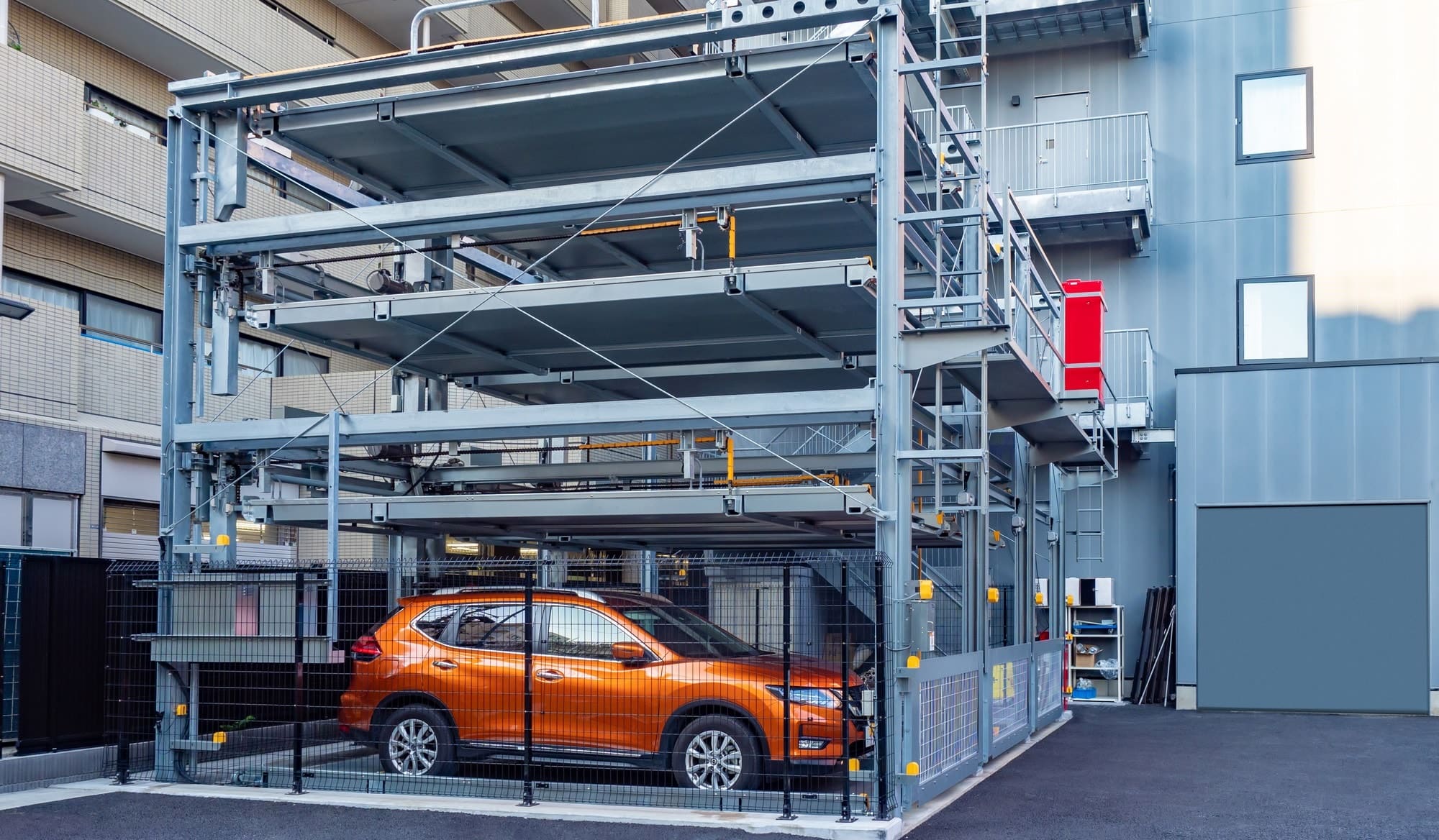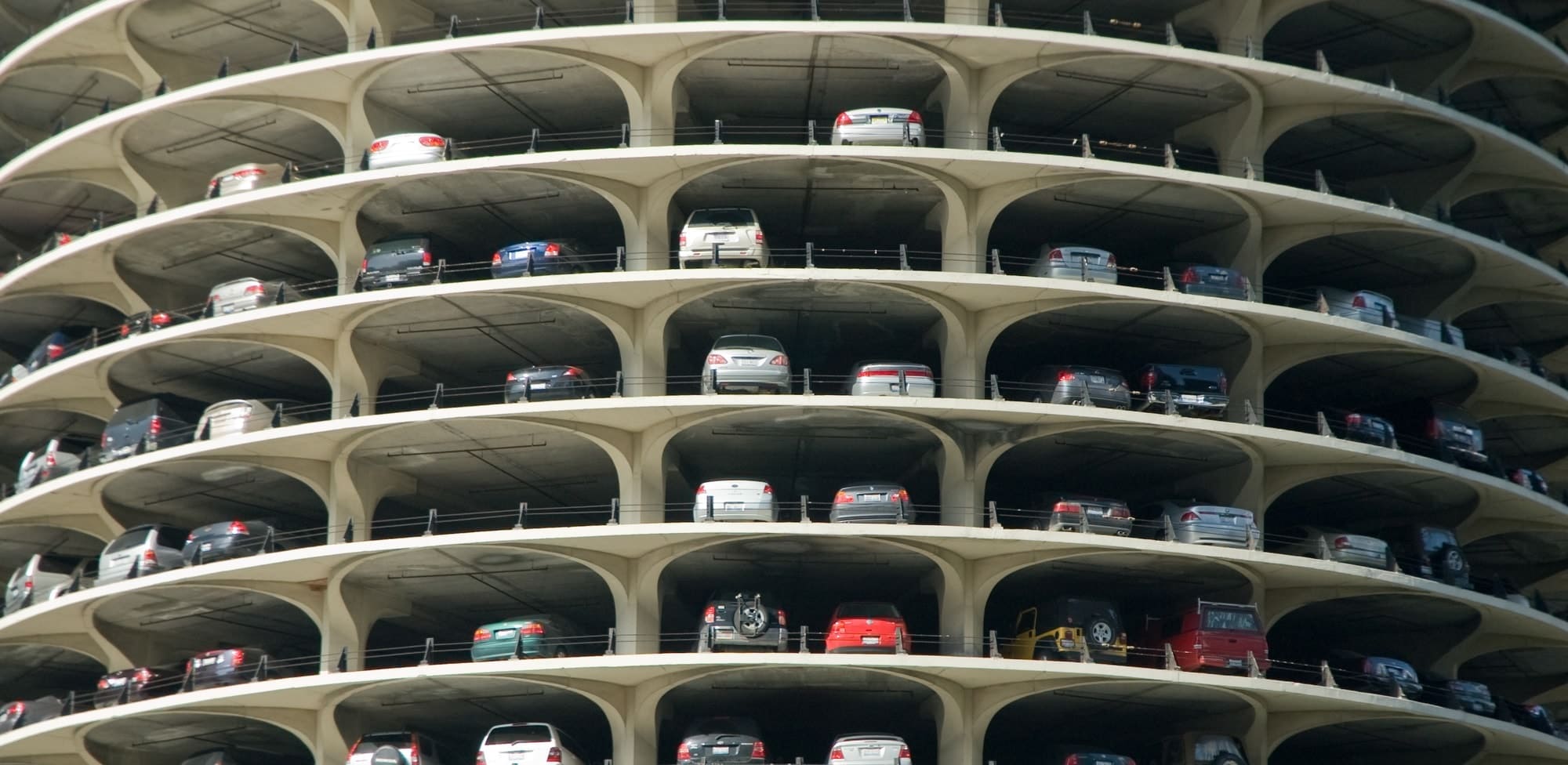In fact, they are used as a very efficient VW car warehouse, where cars are transported by conveyor belt straight from the plant without having driven even a single kilometre. From the customer centre, any customer can collect their brand-new car with the odometer still reading ‘0’.
Each 48-metre-tall tower can hold 400 cars and looks futuristic. However, they are just the next step in the evolution of car parks, which are commonly built using metal and steel structures.
History of car parks
It all started when people learned to get around using something other than their feet. Thousands of years ago, the need arose for a special place to store transportation means. The simplest example of ancient parking is the hitching rail that riders used to tie up their tired horses. Over time, carriages and self-propelled coaches appeared, requiring more space for their storage. As a result, stables and stable yards were created: the medieval equivalent of garages and car parks.
At the end of the 19th century, automobiles started to appear en masse in the streets of large cities. At first, they were parked along the streets. However, growing populations and the chaos that resulted from the increasing popularity of automobiles required special places to park all day while people were working at the office or sleeping. Initially, empty stables were used. However, they did not have enough space to store automobiles, which turned out to be more affordable and easier to use than horse-drawn carriages. Stables were also not located where drivers wanted them to be.
For this reason, parking areas specifically designed for automobiles began to appear at the beginning of the 20th century, including outdoor, multi-storey and underground car parks.
The first enclosed multi-storey car park was introduced in London by City and Suburban Electric Carriage Company, which manufactured electric vehicles. In 1901, the company built a seven-storey building to park 100 cars. It then built other two car parks with 230 and 200 parking spots. The first underground car park was built in Barcelona under Casa Mila, which was designed by architect Antonio Gaudi.
That was the first attempt to mechanise a parking process; cars were lifted to the upper levels using service elevators. However, valets were used to park a car in the right parking spot.
Asphalt, reinforced concrete, and steel structures: who builds car parks and what car parks do they build
A hundred or more years ago, car parking was a pressing problem in the central parts of cities where large office buildings or hotels were located. Nowadays, it is a global problem. Even in Ukraine, where more than seven million cars are registered, you need luck to find a parking spot at rush hour in the business district of Kyiv or other urban centres with populations of a couple hundred thousand people.

Temporary car parking is not only a problem for central areas of major cities. Urbanisation has concentrated populations in cities. More and more residential areas with multi-storey buildings are being constructed and their residents have 2-3 cars per family. These ‘iron horses’ need also to be parked somewhere.
Around 30-40 years ago, the problem could be solved by creating private garages in the courtyards of residential areas. That is no longer enough, because the number of cars is rising. People also want their beloved cars to be at hand day and night, when staying at a hotel or going to an entertainment centre together with their families, rather than getting in the way of pedestrians and environmental activists.
As demand begets supply, so car parks designed for dozens or hundreds of cars started to appear. Nowadays, there are four main types of car parks:
- outdoor car parks at asphalted or unsurfaced sites
- underground car parks
- multi-storey reinforced concrete car parks
- multi-storey steel car parks
Outdoor car parks require a lot of space and underground ones must be included in a building’s design.
Typically, it is difficult to find a parking lot in a central business district or residential area of a city with dense development, or if developers did not provide for an underground parking area in the design.
The best way to address this transport issue is to build multi-storey car parks with space for many cars. Such car parks are relatively compact. They can be built as individual structures or attached to existing buildings.
Notably, amendments to Ukraine’s state building codes (DBN) came into force in summer 2019, significantly simplifying the engineering and construction of multi-storey car parks at public buildings and structures (DBN V.2.2-9:2018. Public Buildings and Structures. General Provisions). The car park must meet the DBN standard for car parks and garages.
Material for multi-storey car parks
Reinforced concrete has been used as the main material for multi-storey car parks for a long time. However, with advances in metallurgy and growing production of steel and rolled products, it became clear that a car park made from steel structures may cost less and take less time to build: just a few months.
Therefore, designers and builders are paying more attention to steel car parks. There are also functional examples in Ukraine that can be seen and touched.
Steel multi-storey car parks are structures built using light thin-walled steel structures (LTWSS). Beams, channels and flat rolled steel are used for framing. This includes a wide range of rolled steel, such as sandwich panels, metal tile roofing and profiled sheeting.

Such buildings can meet fire resistance requirements. To protect structures against exposure to sun, wind, rain or snow, they are coated and painted.
Future of car parks
The automated parking facility in Wolfsburg clearly shows the capabilities of the technology. For example, these towers inspired the creators of “Mission: Impossible”. In the fourth film of the series, Ethan Hunt (Tom Cruise) fought evil in a very similar “beehive” with cars that was located in Dubai, according to the script. In fact, this structure was specially created for filming.
There is an automated parking facility in this city, though, located in the Emirates Financial Towers. While it may not be as spectacular as the one in the movie, it is very efficient and is designed for 1,191 cars. This car park was considered the largest in the world for a long time. However, in late 2017, a parking facility for a court in Kuwait earned the Guinness World Record for the largest automated parking. It has 2,314 parking spaces.
Where else are automated parking facilities in operation? At Dusseldorf Airport in Germany, a traveller hands off their car to Ray the robot, which scans the car and transports it to one of 249 parking spots. This solution helped to increase the available parking space by 60%. Travellers no longer need to drive through each storey of the car park looking for a parking spot, running the risk of missing their flight.
Carousel (rotary) parking facilities made from steel structures are common in Japan and Romania. Even though they are not state-of-the-art, they can park 15-20 cars in a very compact space. Such a solution is likely to be the most promising for cities in Ukraine.
It is just a matter of the efficiency of police and traffic services. Hundreds of tow trucks operate in Kyiv. Drivers have finally realized that it is better and cheaper to pay for parking than a fine for parking on pavement, grass or in a no-parking zone.
This opportunity for business is not limited to automobiles. As a result of traffic jams, more and more Ukrainians and residents of other countries are switching to two-wheeled transport. Local authorities are creating and developing the appropriate infrastructure, including bicycle racks. Private business is also not standing idly by. For example, a bicycle hub has been created in the centre of Kyiv offering a range of services for fans of two-wheeled transport: from day and night parking to co-working spaces and a bike-in cinema.
The main structures of such facilities are made from steel pipes and rolled sections. The need for more complex bike storage facilities in Ukraine is a longer-term issue. However, there is always the option to refer to the experience of Japan, which is famous for its ability to find efficient and compact solutions. They have built underground automated parking facilities designed for several hundred bicycles. This is not just a nicely bent stainless pipe, it is a high-tech project that is as efficient as Volkswagen towers, albeit hidden from human eyes.
